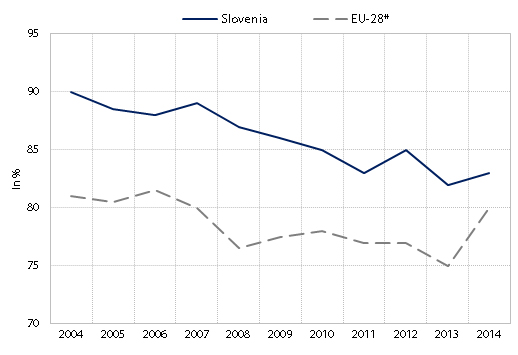SOCIAL WELL-BEING – Satisfaction/happiness
The indicator Life satisfaction measures the subjective level of general satisfaction of the population. This means that it covers all areas of life that have an important impact on an individual’s life. It is a synthetic indicator that belongs among the most important expressions of the well-being of individuals. It shows the share of satisfied people (very satisfied and satisfied together). Growth of the indicator has a positive impact on well-being.
Figure: Life satisfaction, Slovenia and the EU, 2004−2014 (in %)

Source of data: Eurobarometer.
Notes: (1) *EU-28 from 2010 on, before that EU-27. (2) Except for 2004 the figure is the average of both measurements in the same year. (3) Satisfied covers satisfied and very satisfied.
The share of satisfied persons (in 2013 82%, in 2014 83%) in Slovenia is at a relatively high level, higher than the EU average (80%). It has been higher than the EU average since 2004 and the highest among new Member States until November 2013 when Slovenia was overtaken by the Czech Republic and a year later also by Poland. The share of people satisfied with their lives in Slovenia has been declining since 2004 and was the lowest in 2013. Since 2008 satisfaction has dropped more than in Slovenia only in Greece, Spain and Cyprus. Satisfaction with social protection systems, public administration efficiency, inequality and poverty, etc., has been in sharp decline.
Results of the supplementary indicator show:
The happiness indicator shows that the average assessment of happiness given by people in Slovenia in 2014 (according the provisional data) was 7.07 (on the scale from 0 to 10), which is much lower than in 2012 (7.26). The average assessment of happiness has been declining since 2010, when it was the highest (7.28) and has always been slightly below the average of EU Member States included in the European Social Survey (ESS) (2012: 7.45).
